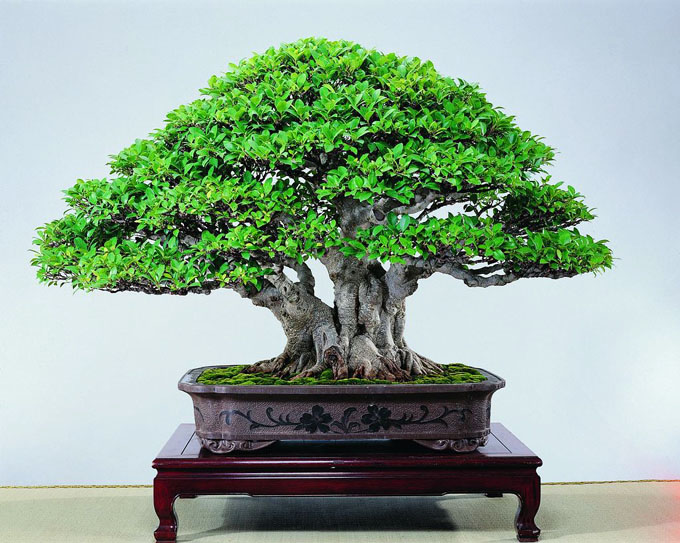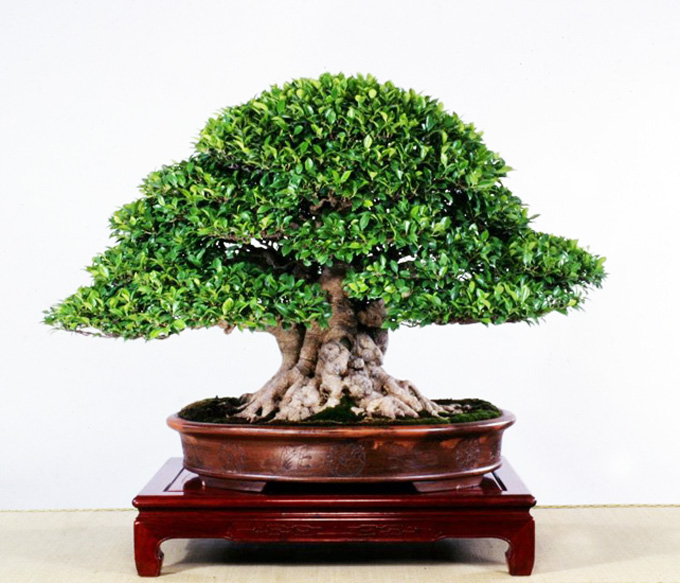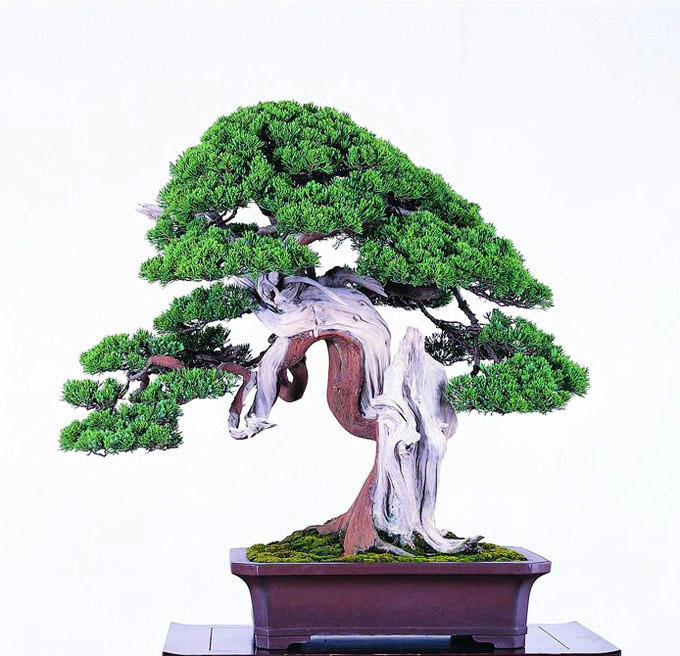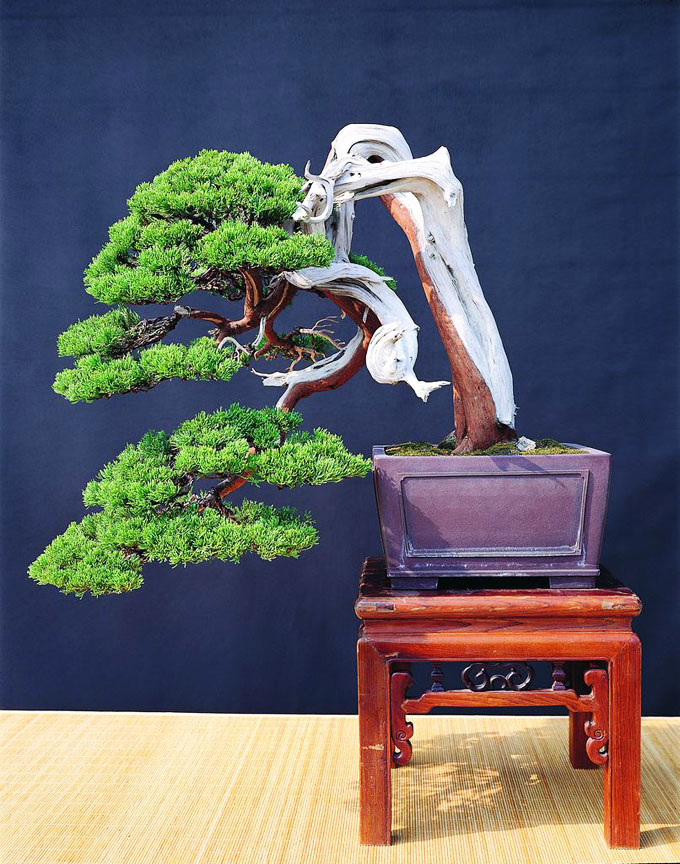 I believe we’ve shown this remarkable tree before, but it’s worth another shot. It’s easy to be impressed by a tree like this; it’s massive girth and equally massive spread alone compel our attention. But there’s more of course; the strong nebari that helps create an overall sense of stability and balance, the texture and movement of the trunk and lower branches, the lush thick canopy with just enough open space to keep it from being too heavy, and so on. Altogether a world-class bonsai. This tree and the rest in this post are by Cheng, Cheng-Kung, a world-class bonsai artist.
I believe we’ve shown this remarkable tree before, but it’s worth another shot. It’s easy to be impressed by a tree like this; it’s massive girth and equally massive spread alone compel our attention. But there’s more of course; the strong nebari that helps create an overall sense of stability and balance, the texture and movement of the trunk and lower branches, the lush thick canopy with just enough open space to keep it from being too heavy, and so on. Altogether a world-class bonsai. This tree and the rest in this post are by Cheng, Cheng-Kung, a world-class bonsai artist.
Taiwan is the home of some of the best bonsai talent in the world. The result, as you might expect, is some of the best bonsai in the world. In this case the talent and the bonsai belong to Cheng, Cheng-Kung. Mr. Cheng is know for, among other things, his extraordinary Silk Carving Techniques (Si-Diao), a method of peeling wood fibre without leaving any tool marks. I won’t say much more, but if you’re interested, you can visit Cheng’s website or if you’d like there’s always a simple google search.
 Another powerful Ficus by Cheng. My guess is that if you saw this tree (these trees) in person, you’d be floored and your socks would come off (something like that).
Another powerful Ficus by Cheng. My guess is that if you saw this tree (these trees) in person, you’d be floored and your socks would come off (something like that).
 This exceptional bonsai is a Silverthorn (Elaeagnus pungens). I don’t think we’ve ever featured a Silverthorn before, which might lead you to the conclusion that they are not all that common as bonsai. Then there’s our oft-mentioned ramification (fine branching), as well as the bark, taper and the magnificent pot, whose color I’m not sure I’ve ever seen (that makes two firsts), though screen colors can play tricks.
This exceptional bonsai is a Silverthorn (Elaeagnus pungens). I don’t think we’ve ever featured a Silverthorn before, which might lead you to the conclusion that they are not all that common as bonsai. Then there’s our oft-mentioned ramification (fine branching), as well as the bark, taper and the magnificent pot, whose color I’m not sure I’ve ever seen (that makes two firsts), though screen colors can play tricks.
 This one and the next one are Shimpaku junipers, a favorite species throughout the bonsai world. Many Shimpaku from Taiwan seem distinctive to my eye, but rather than try to figure out why, we’ll just show these two and leave it at that.
This one and the next one are Shimpaku junipers, a favorite species throughout the bonsai world. Many Shimpaku from Taiwan seem distinctive to my eye, but rather than try to figure out why, we’ll just show these two and leave it at that.

Wayne,
The trees posted in this thread were indeed woked on by Cheng Lao Tze, but none, minus the Elaeagnus, belong to him. Like most of the works featured in his book, the trees belong to clients of his. The first ficus belongs to Mr. Chiu Sen Pu. Cheng Lao Tze reshaped it for three years and submitted it as an entry to the NBAT Show in 1997, winning first prize.
The second ficus belongs to Mr. Su I Chi. It was shown in the 5th Asia Pacific Bonsai and Suiseki Exhibition in Taipei, where it also won a top award.
The Silverberry (Elaeagnus formosana) has 30 plus years of work and has been shown and selected as one of the top entries in the Taiwan Bonsai Creators Exhibition.
The first Taiwan juniper also belongs to Mr. Su I Chi ans was shown in the 5th Asia Pacific Bonsai and Suiseki Exhibition.
Lastly, second juniper was developed from Raw field grown stock for a period of four years to its present shape. It is also a crossroad approach, as more emphasis is placed on the lines than on tje canopy; a feature now commonplace in Cheng Lao Tze’s current designs.
Warm regards,
Jose Luis
Wayne,
It was good to talk to you over the phone. One thing I always like to stress when talking about Taiwanese Junipers is the fact that they are NOT collected trees. With very few exceptions (three that i know of, and they are all Sonare junipers imported from Japan), one hundred percent of Taiwanese juniper bonsai come from field grown stock.
Many people have seen pictures of the Taiwanese high mountain junipers in Hualien (Taroko National Park). Having seen these, there is often the misconception that perhaps some of the famous Taiwan juniper bonsai have been collected from these mountains. Fortunately, I am glad to say no.
The natural Juniperus squamata, var. tarokoensis are illegal to collect and will not survive the lower altitudes where the vast mayority (perhaps 100%) of the bonsai community is situated. For many years, bonsai farmers have learned to cultivate juniper stock in fields. Most importantly, youn trees are bent into shape and further contorted when planted in the open ground with the aid of ropes, bamboo stakes or a combination of both. Unlike yamadori junipers, Taiwanese field grown junipers always exhibit strong root buttresses and swollen water lines which firmly grasp the soil. This characteristic is not present in collected junipers.
On another note, many Taiwanese junipers have been exported to Europe and Japan. Because of the colder climate and improper foliar management, some have reverted to juvenile form. Some artists have chosen to replace the leaves with Itoigawa and Kishu shimpaku. In my opinion, the aforemtioned happens because people choose to pinch rather than replace terminals by means of foliar selection.
I hope my info helps you and your readers better understand the Taiwanese approach to bonsai. There are many forms of bonsai expression and we should always strive to learn from each and every one. At the end, we forge our own bonsai path (bonsai dao tu/ bonsai journey).
Regards,
Jose Luis
Thanks once again Jose Luis,
As always you have enriched Bonsai bark with your knowledge and insights. Keep ’em coming.
And ditto, it was nice to finally get a chance to chat with you voice-live.